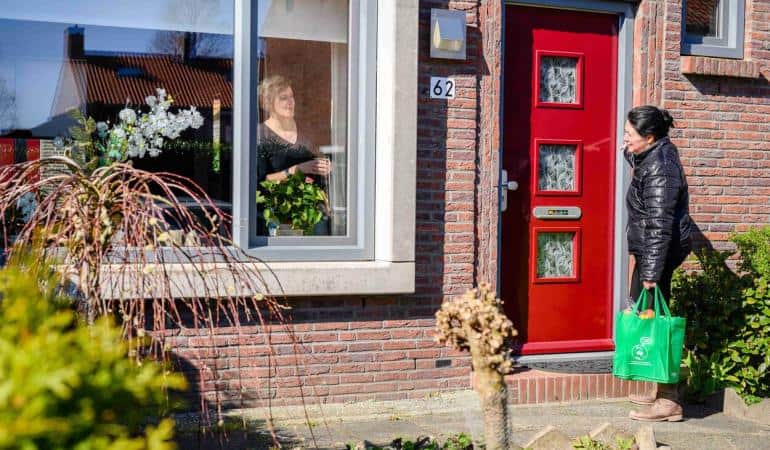The Dutch National Institute for Public Health and the Environment (RIVM) set up a specific corona behavioural unit to provide coordinated scientific behavioural support to policymakers and government during the pandemic. Since starting work in mid-March 2020, the unit has been conducting a large-scale study that explores human behaviour during the coronavirus pandemic. Do people comply with the government’s behavioural measures? What do they think of these measures? And how are they doing physically, mentally, and socially in these corona times?
By Mariken Leurs, head of RIVM’s Centre for Health and Society and of its coronavirus behavioural unit.
Coronavirus measures in the Netherlands
In the Netherlands, various behavioural measures aimed at reducing the spread of the COVID-19 have been in force since mid-March, such as avoiding handshakes, working from home if possible, avoiding travel abroad & maintaining a distance of at least 1.5 metres from each other. If people believe that these behavioural rules will help to prevent infection (their own or others), people are more likely to stick to them. However, the current situation demands a great deal from people. – These rules limit our freedom and our possibilities – This could have an impact on our mental, physical and social health, and on how long people will support the measures.
Corona behavioural unit
Our special corona behavioural unit aggregates, channels and provides direct access to expertise in the field of behavioural science. Its aim is to inform and support policy and government communication at national and regional levels. Using an adaptation of the Health Belief Model as a theoretical basis, the corona behavioural unit utilises the vast wealth of knowledge on behaviour, psychology and health available in the Netherlands.
The unit’s core-team consists of prof. Marijn de Bruin (head of research), prof. Reint Jan Renes (head of communication advice), Margriet Melis MSc (overall coordinator), Sandra Kamga MD (secretary) and myself, Mariken Leurs PhD (head of RIVM’s Centre for Health and Society, and head of this particular unit). An advisory board of 15 professors in behavioural sciences, all with no direct affiliations to our institute, provide independent scientific advice. In total, over 50 people are working currently on one or more aspects of the unit, divided over 9 different work packages.
Study components
The human behaviour study consists of various components -including literature reviews, interviews, social media monitoring, accelerated in-depth research, knowledge integration, and a survey. The survey was conducted in cooperation with all 25 municipal public health services in the Netherlands. It asks questions about preventive behavioural measures, overall well-being (physical, social and mental), and how people access information. The survey, which was first conducted in mid-April, is repeated every few weeks throughout the pandemic, coordinated by work package leader Caroline van Rossum PhD.
Results second survey
The survey was conducted for a second time between 7-12 May. The 53,000 people aged above 16 that took part had also participated in the first survey. The results showed that the measure to keep 1.5 metres distance from others was increasingly difficult for people to adhere to. People with a higher risk of serious illness from a coronavirus infection were generally better at following the measures. The survey also showed that support for hygiene measures, staying home in case of cold symptoms, and physical distancing remained unchanged at 90-95%.
Nonetheless, compared to mid-April, the number of respondents who said that others seldom or never came within 1.5 metres of them was decreasing for the areas of work (-5%), shopping (-9%) and visiting family and friends (-12%). Similarly, the number of people who said they found distancing to be difficult or very difficult increased (+5%).
Behavioural models useful in COVID-19 prevention
We also looked at factors that predict how people respond to behavioural guidelines. The results showed that people who felt threatened by the virus and were concerned about it followed the behavioural rules more closely. Respondents who indicated in the first survey that they had confidence in the effectiveness of the measures and that they were able to implement the measures properly were also more likely to still be following the measures three weeks later.
In addition, although the differences were small, persons whose health was more fragile reported to be more likely to follow hygiene measures and stay 1.5 metres apart. That also applied to people over the age of 70, who were less likely to visit people whose health was more fragile. The results suggested that that older people and people with more fragile health were following the behavioural guidelines more closely.
These results are in line with prominent behavioural models, suggesting that these models are also useful for understanding behaviour during this pandemic.
Widespread support for the guidance “avoid crowds”
The new instruction to avoid crowds, which was introduced on May 6th, was well received as a replacement for the guideline of staying home as much as possible. As many as 95% of respondents said they supported this new behavioural rule, compared to 82% support for the previous rule. Just as in the first survey, overall support was high for such rules as the hygiene measures (90-95%), staying 1.5 meters apart (93%), and staying home in case of cold symptoms (92%).
Rules and guidelines that limit our social life received less support. That included minimising the number of visitors to the home (80%) and working from home as much as possible (81%). The least popular measure was the rule that limits visits to people over the age of 70 to just one or two designated people. 71% of participants supported that measure.
Ambiguities
The study also revealed a few ambiguities. For example, it is striking that people who believed that they were at higher risk of becoming infected were more likely to adhere to the hygiene measures, but were less likely to keep 1.5 metres from others. This may be explained by the fact that these people experience difficulties maintaining a distance of 1.5 meters towards others, and therefore think that their risk of being infected is higher. RIVM hopes to provide more insight on this matter through further in-depth research.
The survey will be conducted at least three more times over de coming weeks. Together with new insights gained from literature reviews, in-depth interviews and specific mix-method approaches, the survey can help answer specific questions, for example regarding self-tests, we provide the Dutch Ministry of Health with frequent research updates & communication advice. Additionally, results are reported to local governments by the collaborating municipal health services.
Useful links
- Results of the first survey https://www.rivm.nl/en/news/15-metre-society-is-difficult-to-maintain
- Results of the second survey https://www.rivm.nl/en/news/staying-15-metres-apart-is-growing-more-difficult
- Results of the third survey: https://www.rivm.nl/en/news/many-people-willing-to-isolate-at-home-in-case-of-positive-covid-19-test
- RIVM coronavirus research https://www.rivm.nl/en/novel-coronavirus-covid-19/research

Mariken Leurs
Mariken Leurs is head of the RIVM Centre for Health and Society and of its coronavirus behavioural unit. She is a health promotion scientist by education. Her professional career has evolved from health enhancing physical activity, youth care and school health promotion to senior management levels in public health and sports with the Dutch government.

